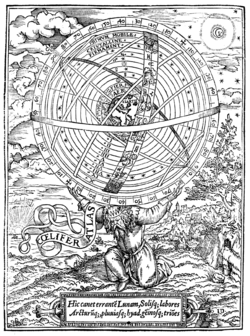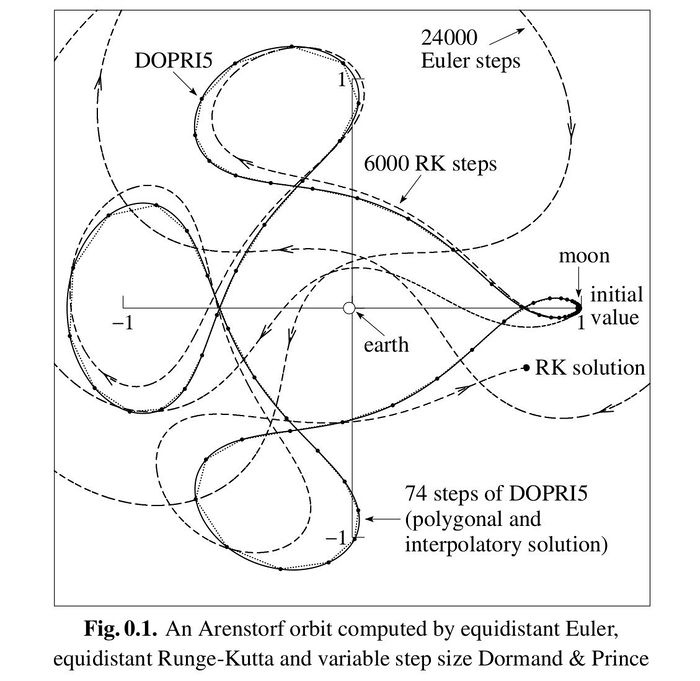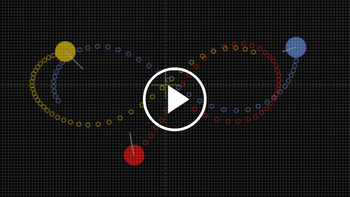Difference between revisions of "Celestial Mechanics Cannot Predict The Solar System"
Tom Bishop (talk | contribs) |
PeteSvarrior (talk | contribs) (editing errors) |
||
| Line 1: | Line 1: | ||
| − | [[File:Atlas Holding Celestial Sphere.png|250px|right|thumb|Atlas Burdened to Carry the Heavens —''The | + | [[File:Atlas Holding Celestial Sphere.png|250px|right|thumb|Atlas Burdened to Carry the Heavens —''The Cosmographical Glasse, 1559'']]It has been asserted many times, and with great insistence, that astronomers can simulate and predict the positions of the bodies in the Solar System for any given time with the Round Earth Theory of the Solar System. Because of this, it is powerful evidence that the system of the Round Earth Theory is true. Kepler's Laws, Newton's Laws, with other Celestial Mechanics equations and resources, are presented as undeniable fact. It is presented in that manner to children in school, in popular culture, and this assertion is seen by our society on a near daily basis. |
The system of the Round Earth Theory has been verified and validated through astronomical and mathematical prediction, as the story goes, and anyone who dare speak a word otherwise is a fool. | The system of the Round Earth Theory has been verified and validated through astronomical and mathematical prediction, as the story goes, and anyone who dare speak a word otherwise is a fool. | ||
| Line 63: | Line 63: | ||
|boxalign=center | |boxalign=center | ||
|align=left | |align=left | ||
| − | |quote=''Because of the existence of chaos, which makes the motion unpredictable on timescales of several times the inverse of the Lyapunov exponent (5 My), the results of these integrations should be regarded only as representative of possible evolutions; however, as seen in the simple numerical examples of Chapter 4, numerical | + | |quote=''Because of the existence of chaos, which makes the motion unpredictable on timescales of several times the inverse of the Lyapunov exponent (5 My), the results of these integrations should be regarded only as representative of possible evolutions; however, as seen in the simple numerical examples of Chapter 4, numerical integration may give an indication of the extent of the chaotic region that is reachable over the integration time.' |
|source=Modern Celestial Mechanics}} | |source=Modern Celestial Mechanics}} | ||
| Line 189: | Line 189: | ||
Adjust the slider values in the upper left to something very slight to find what happens. What you will see is a demonstration of Chaos Theory. Any slight modification to the system creates a chain reaction of random chaos. | Adjust the slider values in the upper left to something very slight to find what happens. What you will see is a demonstration of Chaos Theory. Any slight modification to the system creates a chain reaction of random chaos. | ||
| − | This is precisely the issue of modeling the Heliocentric System, and why its fundamental system cannot exist. Only very specific and very sensitive configurations may exist. The slightest deviation, such as with a system with unequal masses, or the minute influence from a gravitating body external to the system, will cause the entire system to fly apart! The reader is invited to decide for his or her own self whether | + | This is precisely the issue of modeling the Heliocentric System, and why its fundamental system cannot exist. Only very specific and very sensitive configurations may exist. The slightest deviation, such as with a system with unequal masses, or the minute influence from a gravitating body external to the system, will cause the entire system to fly apart! The reader is invited to decide for his or her own self whether those scenarios would happen in nature as described by popular theory. |
==Newton's Explanation: Divine Intervention== | ==Newton's Explanation: Divine Intervention== | ||
| − | The reader may question how | + | The reader may question how Isaac Newton, the authority who "brought the laws of physics to the solar system,"<sup>1</sup> answered this issue. His answer is described in the book ''The KAM Story'' by professor H. Scott Dumas, where we [https://books.google.com/books?id=hy48DQAAQBAJ&lpg=PP1&pg=PA34#v=onepage&q&f=false read the following]: |
{{Quote | {{Quote | ||
Revision as of 15:12, 22 March 2019
It has been asserted many times, and with great insistence, that astronomers can simulate and predict the positions of the bodies in the Solar System for any given time with the Round Earth Theory of the Solar System. Because of this, it is powerful evidence that the system of the Round Earth Theory is true. Kepler's Laws, Newton's Laws, with other Celestial Mechanics equations and resources, are presented as undeniable fact. It is presented in that manner to children in school, in popular culture, and this assertion is seen by our society on a near daily basis.
The system of the Round Earth Theory has been verified and validated through astronomical and mathematical prediction, as the story goes, and anyone who dare speak a word otherwise is a fool.
Readers of history and astronomy, however, will know that this is not how astronomers predict the location of bodies in the sky. The bodies are not predicted based on any heliocentric construct of the solar system and orbits. Prediction in astronomy is based solely on patterns in the sky. Celestial events come in patterns and trends. By analyzing the patterns from past behaviors from historic tables it is possible to create an equation that will predict a future event. This is how prediction in astronomy has been performed for thousands of years, and how it is still performed today.
Thomas Winship provides the following—
"Sir Richard Phillips in his Million Facts, says, 'Nothing therefore can be more impertinent than the assertion of modern writers that the accuracy of astronomical predictions arises from any modern theory. Astronomy is strictly a science of observation, and far more indebted to the false theory of Astrology, than to the equally false and fanciful theory of any modern.
We find that four or five thousand years ago, the mean motion of the Sun, Moon and Planets were known to a second, just as at present, and the moon's nodes, the latitudes of the planets, &c., were all adopted by Astrologers in preparing horoscopes for any time past or present. Ephemerides of the planet's places, of eclipses, &c., have been published for above 600 years, and were at first nearly as precise as at present.'"
The above quote speaks for itself. It is true now as it has ever been.
It may come as a shock to learn that Celestial Mechanics, whether in the days of Kepler, or in its form today, cannot actually predict the placement of any body in the solar system at all. The many computer software applications that predict the locations of the planets are not doing so based on orbital motions in a heliocentric system.
It may come as a greater shock to learn that not only are they unable to predict, they are unable to even model or simulate the basic motions of the solar system based on the heliocentric theory, even on a fundamental level.
We will look at works by professionals in the field who will explain why Celestial Mechanics cannot model the solar system. Who better to consult than those who have labored to predict with the system?
Modern Celestial Mechanics
Aspects of Solar System Dynamics
By Alessandro Morbidelli, PhD
This book begins its introduction by describing Celestial Mechanics as a wonderful and successful tool for the theory of the structure and evolution of the Solar System.
From the first sentence:
|
After the triumphing the success of theory to predict theory, the author, a Mathematician, provides a background on Celestial Mechanics and its ability to predict reality.
|
The reader is informed that Celestial Mechanics is not, and has never been, successful at predicting the positions of planets.
A further definition is given for "chaotic":
|
Another description:
|
Chaos and the Solar System
In Chaos and the Solar System by Paul Trow a good history and description of Chaos Theory is given, with further clarification on the issue of modeling the behavior of seemingly simple systems.
by Paul Trow
|
The author goes on, describing that the motion of planetary systems has been an issue for a long time.
|
The mathematician and theoretical physicist Henri Poincaré was instrumental in showcasing the challenges of Celestial Mechanics:
|
The article continues:
|
From 'Mathematics Applied to Deterministic Problems in Natural Sciences' we read another account of Poincare's discoveries:
|
The Best of the Best
The analytical solution to the three-body problem is the ability to predict where bodies will be based on starting parameters, which is admitted to be impossible.
The numerical solution to the three body problem is essentially the ability to model or simulate where bodies will be, by accounting for the gravitational influences of the bodies at small incremental time steps.
In such simulations the orbits of three bodies with unequal masses will fly apart, and the only available solutions to the numerical three body problem assume unrealistic scenarios-- such as the Restricted Three Body Problem, which assumes that one of the bodies is mass-less.
To demonstrate the state-of-the-art methods for computing the motion of bodies in Celestial Mechanics, poliastro, an astrodynamics software developer, has shared this beautiful plot of several numerical methods for the Restricted Three Body Problem when applied to the Sun-Earth-Moon system, taken from Harier et al. Solving Ordinary Differential Equations I.
|
When the numerical Three Body Problem solutions in Celestial Mechanics are applied to model the movement of the Moon in the Earth-Moon-Sun system we get the following:
The Zeroth Step
In 2017, by testing out many possible orbits to find stable ones, a supercomputer found over one thousand new numerical solutions to the Three Body Problem.
Infamous three-body problem has over a thousand new solutions
|
|
|
As plainly stated, the stable orbits that can be found have nothing that looks like heliocentric astronomy. The system, at its very basic level, is unable to be created.
The "thousands of stable solutions" are scenarios where the bodies have the same mass or where one of the bodies is mass-less. All of these scenarios are incredibly sensitive, and none represent anything that looks like a heliocentric system. They are crazy loopy orbits, based on situations that would not happen in nature, and which fall apart with the slightest touch.
Chaos Theory: A Demo
The available solutions to the Three Body Problem, beyond being unlike anything seen in Heliocentric Theory, are so sensitive that the slightest change or imperfection will tear the entire system apart. As a very illustrative demonstration, take a look at this online Three Body Problem simulator that uses the simplest possible figure eight pattern, which requires three identical bodies of equal mass that move at very specific momentum and distance in relation to each other.
Demo: Figure-Eight Three Body Problem
Adjust the slider values in the upper left to something very slight to find what happens. What you will see is a demonstration of Chaos Theory. Any slight modification to the system creates a chain reaction of random chaos.
This is precisely the issue of modeling the Heliocentric System, and why its fundamental system cannot exist. Only very specific and very sensitive configurations may exist. The slightest deviation, such as with a system with unequal masses, or the minute influence from a gravitating body external to the system, will cause the entire system to fly apart! The reader is invited to decide for his or her own self whether those scenarios would happen in nature as described by popular theory.
Newton's Explanation: Divine Intervention
The reader may question how Isaac Newton, the authority who "brought the laws of physics to the solar system,"1 answered this issue. His answer is described in the book The KAM Story by professor H. Scott Dumas, where we read the following:
|
1The University of California San Diego credits Newton as providing the laws of physics for the Solar System:
|
.
Conclusion
As we have read, it is well admitted that Celestial Mechanics is not, and cannot, be used for the prediction of bodies in the solar system. Nor can it even create a heliocentric orbit of its simplest elements. The idea that it is used with success in astronomy software, and that astronomy literature is able to predict bodies into the future is, to say the least, misinformed. Celestial prediction software such as Stellarium are not "Round Earth" or "Heliocentric" prediction tools.
The n-body problem is the foundation of the entire field of Celestial Mechanics and the massive attempt to show the possibility of Heliocentric orbits. The efforts of hundreds of mathematicians and astronomers over hundreds of years, from the early beginnings, have failed again and again to predict or simulate motion in the system. After so much time, with such great effort by the greatest minds of history to make this system work, Celestial Mechanics is still at step zero. It is an embarrassing stain on the whole of astronomy, mathematics, and classical mechanics. The above works identify the inability to predict or create as "chaos," and from this it takes little effort to transition into a questioning of the system and the science itself.
Not only can astronomy not predict, not only can it not simulate a basic heliocentric system such as a stable earth-moon system rotating around a sun, hundreds of years of research into the matter as one of the greatest unsolved issues in science has thus-far shown that the heliocentric system cannot exist at all.
This Emerald City of Superior Predictive Ability that is used to showcase and prove the factual reality of the Round Earth System in its splendor and beauty, is revealed to be little more than a facade. The predictive power of the Round Earth System is not beautiful at all. When the Wizard's mandatorily worn spectacles, which supposedly protects inhabitants and visitors from the blinding light and brilliance, are removed from the eyes, the city is seen to be no more green than any other city. The proprietor behind the curtain is handing out phony diplomas from his palace, and we are asked to pay no attention.
The following comment left on our forum on this topic is succinct:
|
|
Indeed.
From the failure of theory to meet reality, we are reminded of the following words by Samuel Birley Rowbotham:
|



